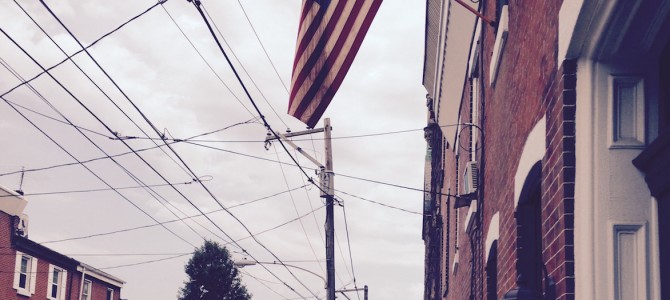
Last week, I wrote about a mostly white, working-class neighborhood in Philadelphia called Fishtown, where I lived for a few years before and during the Great Recession. Like other parts of Philly, its fortunes have been improving recently thanks to the economic recovery and an influx of young professionals. But the natives of Fishtown are not faring as well.
In that sense, Fishtown is a useful proxy for white blue-collar communities across America whose social and economic ills are palpable, and whose residents feel left behind. As a political constituency, they’ve been discarded by Democrats, whose coalition of affluent urban whites and various minorities renders them unnecessary. The GOP, particularly its establishment wing, has never seen much use for them in the first place.
In response, many of these folks are turning to Donald Trump, whose mix of nativist and protectionist rhetoric assuages their cultural and economic anxieties. This election cycle, they’ve become the vanguard of a white identity politics that has little interest in conservative principles like free markets and limited government. They believe something has gone horribly wrong in America, and they think Trump can fix it.
He can’t, but if conservatives want to regain control of the Republican Party and actually govern, they’ll need to reach out to these people and speak to their anxieties—not by pandering to their worst fears and inclinations, but by persuading them that they are wrong about almost everything.
Working-class whites, to the extent they think China and Mexico have taken their jobs and despoiled their communities, are simply mistaken. The problem with their neighborhoods and towns is not primarily economic stagnation, but cultural collapse.
A Study In White Working-Class Decline
Last week, The Washington Post ran a long piece unpacking the results of a massive analysis of 87,000 interviews by Gallup. The survey data shows that although Trump supporters are less educated and more likely to work blue-collar jobs, they’re not necessarily poor. In fact, they earn above-average incomes, a finding that corroborates previous studies. Jonathan Rothwell, the economist at Gallup who wrote the paper, said the “results do not present a clear picture between social and economic hardship and support for Trump. The standard economic measures of income and employment status show that, if anything, more affluent Americans favor Trump, even among white non-Hispanics.”
But they still tend to live in troubled places like Fishtown. Rothwell found that, “social well-being, measured by longevity and intergenerational mobility, is significantly lower” in communities that support Trump. That means places where people die younger and those who grow up poor are more likely to stay poor.
These are the parts of the country where for the past 15 years the mortality rate for middle-aged white men has been rising for the first time since 1968, thanks largely to suicide and drugs. These are also places that, according to Rothwell, are “racially and culturally isolated zip codes and commuting zones,” which means they interact less often with the Mexican immigrants they think are taking American jobs.
Here we come to the crux of the matter. Trump supporters are not in fact suffering disproportionately from the flight of manufacturing jobs overseas, or competition from immigrants. They might not be poor themselves, but they live in places that are in a state of crisis, where the pathologies of the white working class are manifesting themselves in visceral ways: heroin overdoses, single-parent families, rampant opioid addiction, vast swaths of adult men on disability and out of the work force. It’s no wonder they feel like something has gone horribly wrong in their country. It has—but not quite in the way they suppose.
Mobility And Stagnation
One of the major problems is that these areas are incredibly immobile, both economically and geographically. The poor stay poor, and they stay put. Some commentators have posited that because Trump supporters are not necessarily poor, but do tend to live in downtrodden areas, they must not be selfishly anxious about their own economic futures but those of their children and their communities. Perhaps, but lack of economic mobility invites a larger question: if there are no good prospects in these places, why don’t more people abandon them?
Moving to seek one’s fortune, or just sustenance, has been part of the American experience since our founding. From the westward expansion of pioneers in the nineteenth century to the Great Migration of African Americans to industrial northern cities in the early twentieth century, Americans have always been on the move—and with good reason. In those earlier eras, moving was sometimes the only way to avoid starvation. But often it was also a good way to get ahead.
Recent research suggests a causal relationship between economic and residential mobility. A major 2014 study by researchers at Harvard and University of California-Berkeley (PDF) on intergenerational mobility found that children who grow up in wealthier neighborhoods tend to fare better as adults. It also found that these places have common features, like more two-parent families, better schools, and less residential segregation. Even if you’re not wealthy, living in neighborhoods like this increases one’s likelihood of climbing up the economic ladder.
Not that it’s easy. According to Scott Winship of the Manhattan Institute, who published a major study of mobility trends last year, better-educated Americans have always been more likely to move than their less-educated countrymen. That was true in 1860 and it’s true today. What’s different now, though, is that there’s more to be gained by moving. Since about 1980, the difference in earning potential between those who move away from a low-income state and those who stay behind has been widening, for both men and women. So why aren’t more poor white people doing it?
I asked Winship, and he said some of it has to do with comfort. A lot of people in down-scale communities aren’t destitute or in danger of starving like those in early eras, so they’re less motivated to uproot their lives. But plenty of people do leave, and those who are left behind tend to be the least ambitious. “It creates pockets of people who aren’t upwardly mobile,” Winship said. “They’re doing well enough that they don’t have to move.”
Part of why they’re doing well enough is because of growing welfare and disability payments. But it’s not just government welfare. Winship also mentioned the “private safety net,” in which unemployed men rely on a girlfriend or family members, often people who are themselves living on government assistance, for support. These networks of support would likely fray or disappear altogether if they moved away.
So they’re able to get by well enough to stay put, but they’re not necessarily working. Indeed, the number of men age 25 to 54 who have dropped out of the labor force has been increasing for decades. It’s a serious problem, and something of a mystery to economists, who can’t quite explain what’s causing it. Alan Berube of the Brookings Institute recently noted some regional patterns to this phenomenon, which coincide somewhat with areas where Trump has found support: “These include many small former industrial centers in states like Michigan, Indiana, and Ohio; areas of West Virginia and Louisiana that rely on declining-employment industries like mining; and long-struggling agricultural economies in Arkansas, Texas, and inland California.”
Globalization Requires Adaptation
The mobility issue is complex, and there are no easy explanations for why some people move and others don’t, or why working-age men are dropping out of the workforce, or why some parts of the country have been able to adapt to changes in the global economy and some haven’t. There are no perfect answers, but adaptation and mobility—not nativism and protective tariffs—are the best responses to the challenges of globalization and economic stagnation.
After all, the economy isn’t doing that bad right now, even for the working and middle class. You wouldn’t know it from listening to Trump, but poverty rates are down, wages are growing, and unemployment is holding steady. That’s not what Trump’s supporters hear from their candidate. They hear about how global trade has laid waste the American economy, moved millions of jobs overseas, and cheated American workers.
To be fair, international trade has shifted some jobs and industries overseas. But trade creates as well as destroys, and some communities have benefited from it. A front-page report in the Wall Street Journal last week focused almost exclusively on how trade with China has devastated the furniture manufacturing industry in Hickory, North Carolina. But as Hickory native Eric Cunningham noted in these pages, the Journal ignores what helped his town recover: technology.
“Even as the dot-com bubble imploded, telecommunications kept flourishing, and Hickory had become a hub for it,” writes Cunningham. “By 2000, Hickory produced 40 percent of fiber-optic cable in the world. Rather than being content with furniture and textiles, the region had—wisely, in retrospect—expanded its reach and diversified into fiber optics.”
Something similar is happening in regions that once employed coal miners. Eastern Kentucky, which was home to some 67,000 coal miners in 1950, employed just 7,000 in 2014. But a program to train laid-off miners for new careers appears to be working, if still on a small scale. Since 2013, the Eastern Kentucky Concentrated Employment Program has helped more than 1,100 ex-miners find new jobs, like becoming electrical linemen through a program at a technical college.
Make American Communities Great Again
Although adaptability and mobility are necessary to thrive in a changing economy, globalization isn’t what’s really plaguing the communities where Trump’s nationalist message holds sway. The problem requires more than training for a new career or moving to a new state. Economic recovery is one thing; cultural renewal is another.
The truth is, entire swaths of working- and middle-class white America are now afflicted by something much worse than foreign trade or immigration. Their communities are in the throes of a moral and cultural crisis—a breakdown of the family and social institutions that has given rise to drug addiction, welfare dependency, and simmering resentment. Trump supporters who live in these places are understandably frustrated, but they’re wrong to pin the blame on NAFTA, or George W. Bush, or the Obama administration.
Yes, we could have better trade and immigration policies. But that won’t bring back regions of the country afflicted by heroin and broken homes and idle men who refuse to work or move for a job. Maybe it’s not possible to convince Trump supporters of this. But if conservatives ever want to reclaim the Republican Party and win the White House, they’d better stop scoffing at the people who feel left behind and start figuring out a way to bring them along. They need to persuade Trump supporters that they don’t need a border wall or a disability check to “Make America Great Again.” If they want to do that, they need to start by making their own towns and neighborhoods and families great again.
To the extent that there’s a role for the government in all this, conservatives might consider stealing a line from an old-time Democrat, who had the right idea but the wrong policies: “Our American answer to poverty is not to make the poor more secure in their poverty but to reach down and to help them lift themselves out of the ruts of poverty and move with the large majority along the high road of hope and prosperity.”









